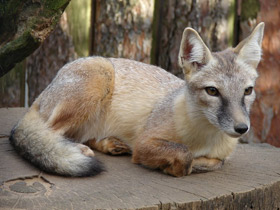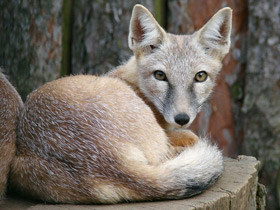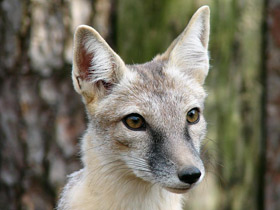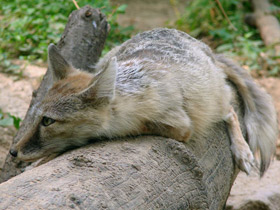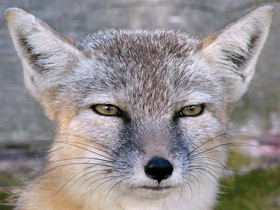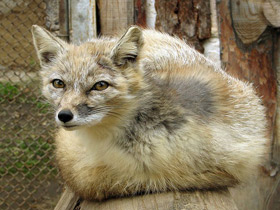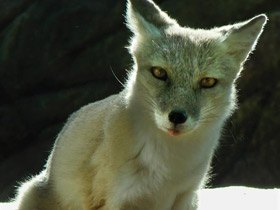The corsac fox or corsac (Vulpes corsac)
The corsac fox (Vulpes corsac), also known simply as a corsac, is a medium-sized fox found in steppes, semi-deserts and deserts in Central Asia, ranging into Mongolia and northern China. Since 2004, it has been classified as least concern by IUCN, but populations fluctuate significantly, and numbers can drop tenfold within a single year. It is also known as the steppe fox. The word "corsac" is derived from the Russian name for the animal, "korsák" (корса́к), derived ultimately from Turkic "karsak".
Appearance
Vulpes corsac is a canid, a very small and colourless fox. It is even smaller than an arctic fox: Vulpes corsac is only 50-60 cm long and 25-35 cm tail; it is 28-30 cm at the withers and weighs between 2.5 and 5 kg. However, its ears are noticeably longer than those of the arctic fox and broad at the base.
A distinctive feature of Vulpes corsac is its broad cheekbones. The teeth of Vulpes corsac (there are 42) are very small, but similar in structure to those of other foxes. The paws of Vulpes corsac are long and the winter coat is very fluffy, soft and silky and, despite its light colouring, beautiful. The summer coat of the Vulpes corsac is yellow-grey, yellow-grey-reddish or sandy shades. The sides and belly of the Vulpes corsac are slightly lighter than other parts of the body. The tail also becomes very fluffy in winter, grey-brown with a black tip; it has a blackish patina on the upper side; and the underside of the tail is light. The coat of Vulpes corsac becomes most beautiful in late November or early February.
Distribution and habitat
Corsac foxes live in the steppes and semidesert of central and northeast Asia. They are found throughout Kazakhstan, Uzbekistan, and Turkmenistan, and through all except the northernmost regions of Mongolia. In the south, their range extends into the more northern parts of Iran, Tajikistan, Kyrgyzstan, Afghanistan, and China, and they can also be found in neighbouring regions of Russia.
Three subspecies are currently recognised:
- Vulpes corsac corsac - northern Kazakhstan, southern Siberia;
- Vulpes corsac kalmykorum - northern Uzbekistan, Caucasus;
- Vulpes corsac turkmenicus - southern Uzbekistan, Turkmenistan, China, Mongolia, and neighbouring regions.
These foxes inhabit open grassy steppes and semideserts, and avoid dense vegetation and mountainous regions. True deserts with drifting sands are also avoided, as are snowfields more than about 15 cm (6 in) deep. Corsac foxes generally stay far away from human disturbances.
Habitat
Occasionally, the species is also found in the eastern part of the Ukrainian steppe. Vulpes corsac belongs to the typical inhabitants of semi-deserts and dry lowland steppes with little or no snow cover in winter. Sometimes it can also be found in the forest-steppe zone and in deserts.
Nutrition and lifestyle
Feeds mainly on small rodents (voles, mice, gophers, gophers, marmots, gerbils, young hares), reptiles, insects, birds and their eggs. Less frequently, it feeds on moles, hedgehogs and hares. In the absence of food, Vulpes corsac eats carrion and various waste, but hardly touches plant food and can do without water for a long time. During the winter, due to the reduction of food and difficulties in foraging, the number of Vulpes corsacs can drop dozens of times.
This small, weak predator often has a hard time, especially after a snowfall, as it becomes deeply entangled in the snow. In many areas, Vulpes corsacs migrate south during the autumn, sometimes following herds of saigas that trample the snow, facilitating movement and hunting. Mass migrations of Vulpes corsac can also be caused by steppe fires or catastrophic rodent die-offs, etc. During these migrations, Vulpes corsacs appear far from their range and even enter cities.
It prefers to hunt at most hares and young marmots, and also eats birds, reptiles and insects, but hardly touches plant food during the summer months. Vulpes corsac often scavenges the remains of saigas, gazelles and other animals mauled by wolves. As for the common fox, Vulpes corsac are bitter enemies; moreover, they have a similar menu and compete for food in snowy winters.
Vulpes corsac live in burrows, which is due to their habitat, with hot days and cold nights in summer and harsh weather in winter, when heavy snowstorms rage. Vulpes corsac uses marmot burrows, adapts to mole burrows, occasionally occupies badger and fox burrows, and digs them itself only in exceptional cases.
The marmot always redoes someone else's burrow in its own style, making up to 4 entrances/exits in it; the length of burrows with transitions varies from 2.5 to 4.5 m. Sometimes burrows are found in groups. Sometimes burrows are found in groups, but only one of them is a dwelling.
Vulpes corsac hunts mainly alone and at dusk, but often during the day. In case of heavy frost and heat it has to lie down in a burrow. During winter storms, it can stay in the burrow for 2-3 days. Before leaving the burrow, Vulpes corsac carefully looks out of the burrow, then sits close to it, looking around, and only then comes out to hunt. Vulpes corsac has a good sense of smell and hearing. When hunting, it walks slowly or walks against the grain, and when it detects its prey, it hides it or tries to hunt it. If necessary, the fox can reach speeds of up to 40-50 km/h, and can run up to 15 km during the day. Vulpes corsacs are sometimes very skilful at feigning death, but flee at the first opportunity.
Social behaviour and reproduction
Vulpes corsac are more social than other foxes, and it is not uncommon for several animals to live together in "Vulpes corsac towns". The resulting pairs of Vulpes corsacs persist throughout their lives and only disintegrate if one of the animals dies. In winter, they form a small hunting group, possibly consisting of a married pair and their reared young. The hunting territory of a pair is usually 35-40 km2 (sometimes up to 100 km2). Vulpes corsacs express their emotions with various sounds: they moan, shriek, bark, howl and growl. When raising their young, the animals often bark to protect them.
The Vulpes corsac often stalks at night and is accompanied by barking from the males. Young or "single" females are chased by several males, and fights between them are common. Mating takes place in a den. Pregnancy lasts between 52 and 60 days, and cubs are born in March or April. There are 2 to 11-16 cubs in a brood, but most often 3 to 6. Newborn cubs are blind, covered with light brown wool, their body length is 13-14 cm, and they weigh about 60 g.
They acquire their sight between 14 and 16 days; at one month of age they begin to eat meat. Both mother and father care for the young, although they live separately. Vulpes corsac burrows are heavily infested with parasites, so during the pups' growth period the female changes burrows 2-3 times. At 4-5 months of age, the pups reach adult size and disperse. However, with the onset of cold weather, the young Vulpes corsacs gather again and spend the winter in the same burrow. Puberty in Vulpes corsacs occurs at the age of 9-10 months. Longevity under natural conditions is unknown; it is probably the same as that of foxes and ranges from 3-6 years under natural conditions and up to 12 years in captivity.
Evolution
The corsac fox is one species within a holarctic clade of foxes that also includes the red fox, the swift fox and the Arctic fox, all of which it resembles. However, the closest related species to the corsac fox is probably the Tibetan sand fox. The immediate ancestor of the corsac fox is believed to be the extinct species Vulpes praecorsac, which lived in central Europe during the early Pleistocene. Fossils of corsac foxes date back to the mid-Pleistocene, and show the species once reached as far west as Switzerland, and as far south as Crimea. Very recent subfossil remains dating to 3000 to 1000 B.C.E. have in found in the Crimea and 0 to 1500 B.C.E. in the Donev River Basin in the northern Black Sea region.
Threats
The major threat posed to the corsac fox is poaching, as it is a valuable fur-bearing species and has been harvested by humans since the Bronze Age for subsistence and commercial purposes. It is a slow runner and therefore easily caught by hunters; the population has been reduced in areas where it has been heavily hunted for its fur. Traditionally, the corsac fox is often hunted with trained domestic dogs, saker falcons, and golden eagles, as well as caught with traps set at burrow entrances, leghold traps, and firearms. In the late 19th century, up to 10,000 foxes were killed annually for pelt trade. The general population remains healthy, however, as the corsac fox has proven to be able to withstand great hunting pressures, and their habitats remain intact due to the low human population density in its range.
Other threats include overgrazing by livestock and landscape development; the decline of marmots may also impact the species in some areas, as it often uses marmot burrows as daytime resting locations. The other main threat is natural disasters, which can cause the numbers of foxes to drop 90% in some areas, but the population often recovers quickly. As of 2014, the corsac fox is listed as least concern in the IUCN Red List.

















